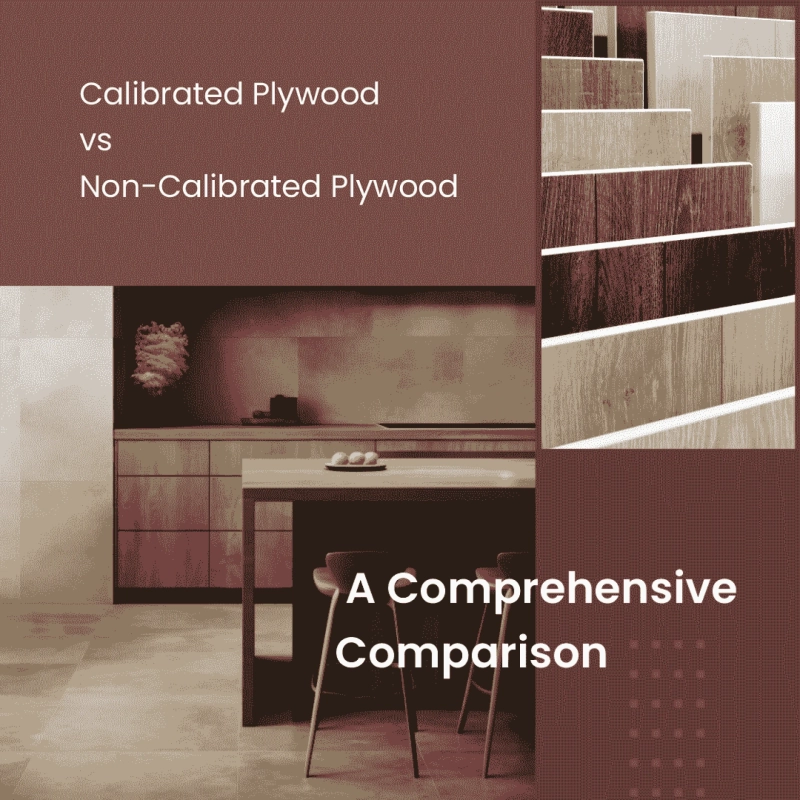In the field of construction as well as furniture crafting, one of the most used materials thanks to its strength, longevity, versatility, as well as cost-effectiveness is plywood. Right from building construction to woodworking, plywood serves as a foundational element in a number of applications. However, the key factor that can affect the suitability of plywood for different applications is the process of calibration.
There is a significant difference between calibrated and non-calibrated plywood. It is important to understand the same to be able to make the right choice of plywood for your project. In this blog, we will make a comprehensive comparison between calibrated plywood and non-calibrated plywood, and understand which plywood you should go for.
What does it mean for plywood to be calibrated?
Also known as engineered wood, plywood that is calibrated goes through a rigorous process of manufacturing to ensure evenness in thickness throughout the plywood sheet. Such a precise process of calibration gives the plywood consistency in thickness, with a maximum tolerance of +/- 0.50 mm, depending on the specifications of the manufacturer.
The surface of such plywood is usually given a smooth and even finish This makes it all set to be used immediately in projects where accuracy and precision in dimensions are of the utmost importance.
What is non-calibrated plywood?
On the other hand, non-calibrated plywood does not have the precision in thickness as does the calibrated one. Even so, non-calibrated plywood is still popularly used despite its variability in dimensions. Such unevenness can be caused because of inconsistencies in the thickness of the veneer used, improper application of the adhesive, differences in the manufacturing process, and more.
To be fit for use, such non-calibrated plywood requires extra sanding as compared to calibrated ply to attain the required level of thickness and smoothness of the surface.
Difference between calibrated and non-calibrated plywood
Precision
As we have already seen, the foremost point of distinction between calibrated and non-calibrated plywood is the level of precision and consistency that goes into its process of manufacturing. While plywood that has been calibrated has an even thickness that makes it suitable for use in projects that require accuracy, non-calibrated plywood exhibits comparatively greater discrepancies in thickness, resulting in more efforts to make it usable.
Smoothness
Plywood that has been calibrated undergoes a process that is so precise that it results in a finely sanded or planed surface that gives it a smooth and even finish. Such a process makes it one of the best plywoods in India, making it free from undulation, flaws, or imperfections. On the other hand, because non-calibrated plywood does not go through such a meticulous process, its finish is not as smooth. It can, at times, have the natural texture of wood, roughness, or irregularities in thickness with disparities on its surface.
Cost
The key difference between calibrated and non-calibrated plywood that becomes a major point of concern for a number of people when choosing the right type of plywood is its cost. While the former is comparatively a cost-heavy alternative, the benefits it offers are also numerous. Such additional cost is because of the accuracy and precision that goes into the process of manufacturing. However, the higher initial cost of calibrated sheets of plywood can be offset by the additional expenses that can be incurred if you go for non-calibrated plywood.
Performance
Calibrated sheets are considered to be the best plywood in India because they offer unparalleled performance, thanks to the consistency in their thickness and evenness in their finishing. This, in turn, results in stability and better structural integrity of your end products. On the other hand, plywood that is not calibrated gives inadequate performance for various applications. This can significantly affect the integrity of your structures and its load-bearing capacity.
Durability
Calibrated sheets of plywood when used in a structure result in its overall enhanced durability – that is because of its evenness and smoother surface, your structures become resistant to water, moisture, warping, and any structural damage that comes with time. This leads to the plywood providing a long-lasting performance in a number of applications. On the other hand, non-calibrated plywood is not particularly known for its durability. It can depend on a wide range of factors such as the type of wood used, the quality of the manufacturing process, and the environmental conditions your structure is exposed to. Such non-calibrated plywood also becomes more susceptible to damage because of water, moisture, and other issues in the long term.
Concluding thoughts
To sum it up, the choice between calibrated plywood and non-calibrated plywood depends on a number of considerations. However, if your project demands high levels of precision and uniformity in thickness, the clear choice is to go for plywood that has undergone the process of calibration as it is corrected plywood with a zero gap finish that offers the highest performance among all types of plywood.


